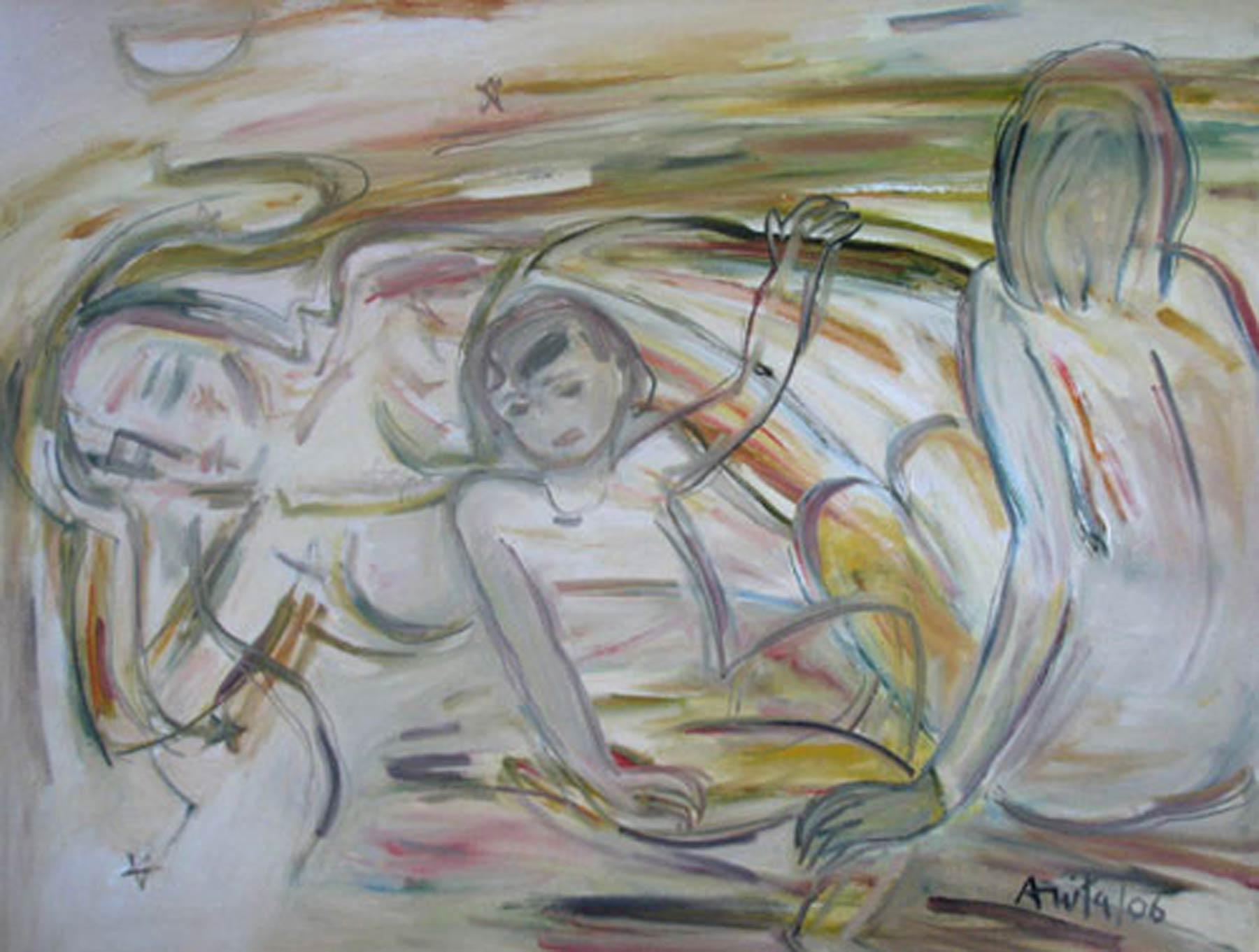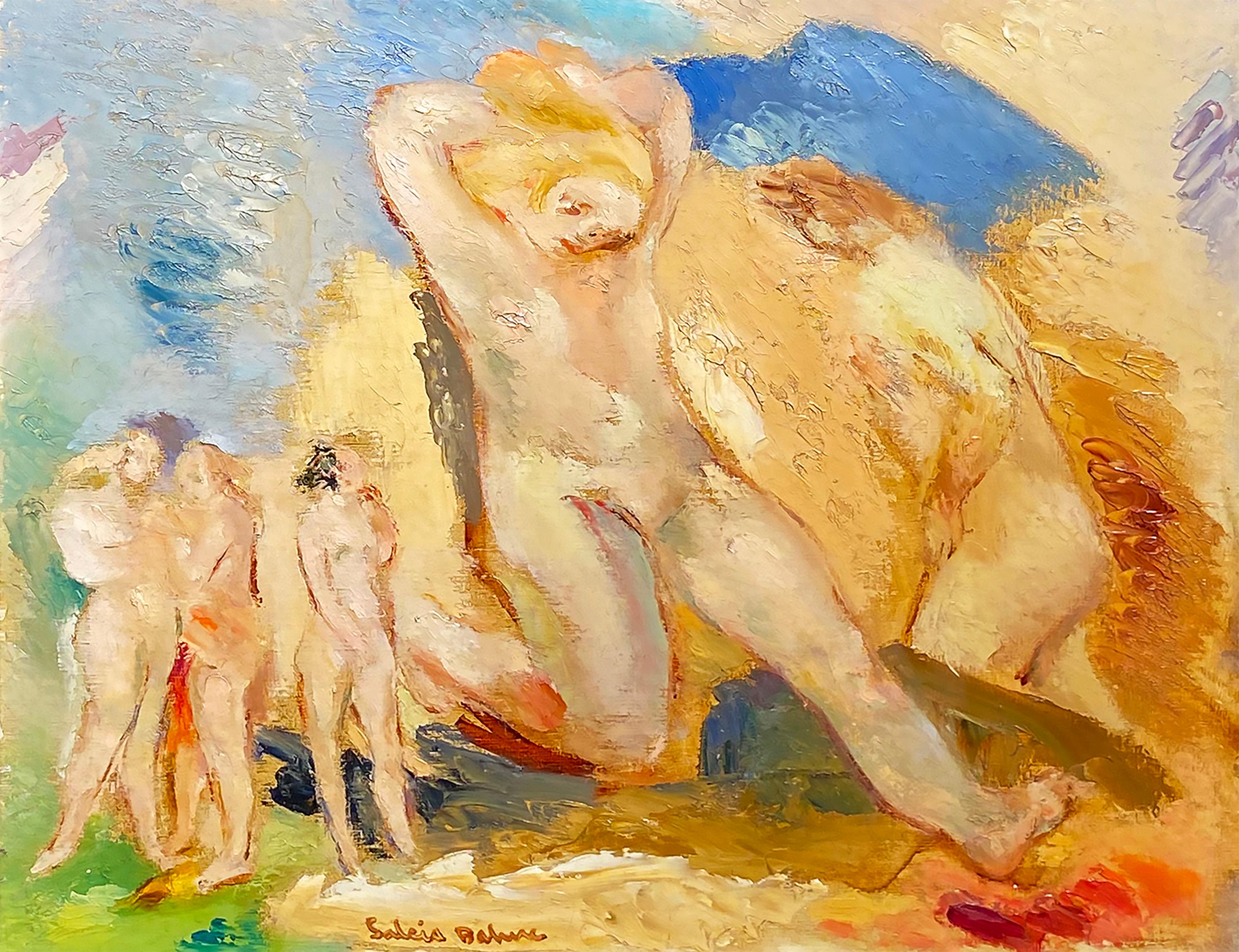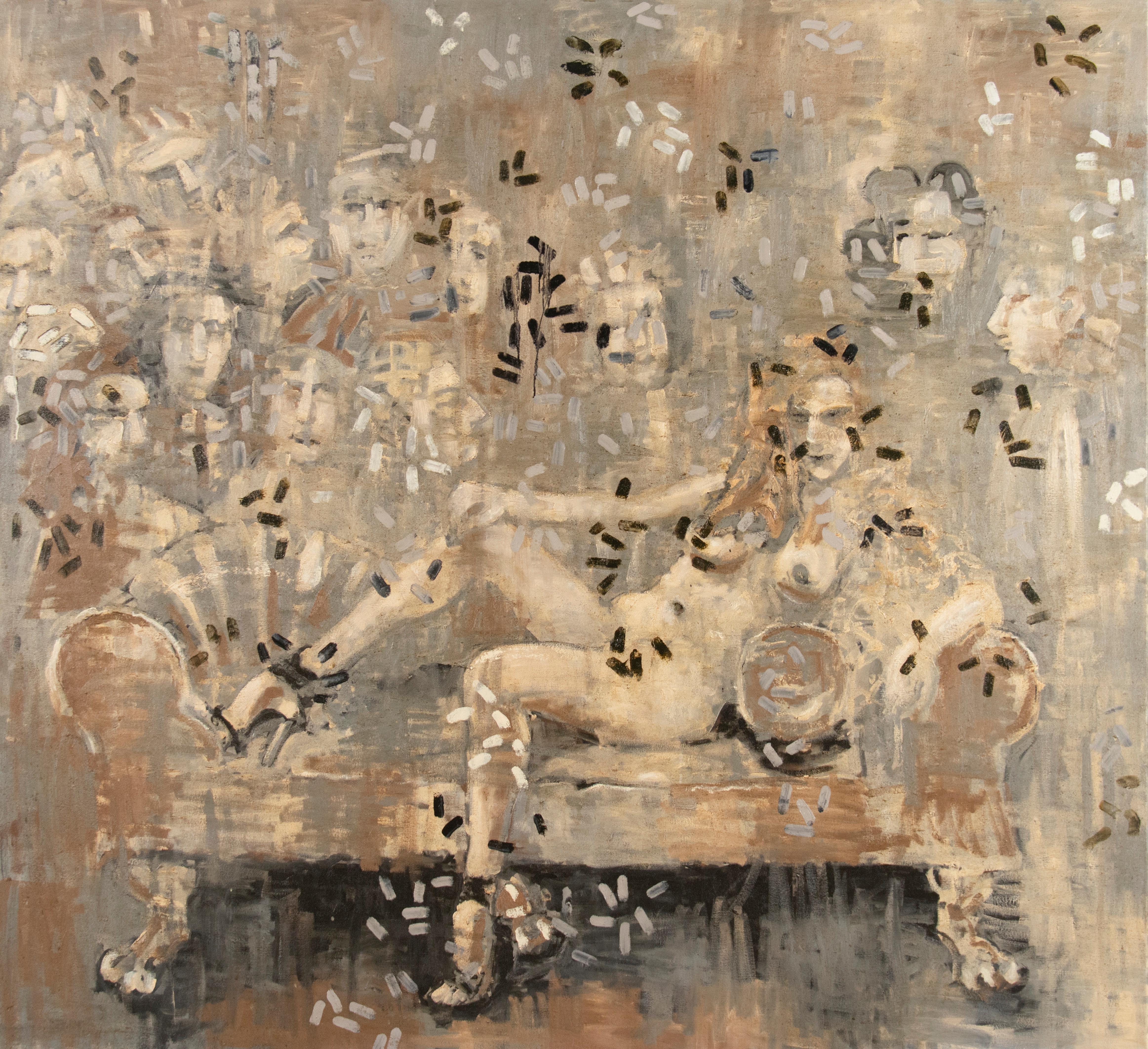SOPHIE DUMONTrêveries, woman nude, oil, figurative, contemporary expressionism, french 2016
2016
About the Item
- Creator:SOPHIE DUMONT (1964, French)
- Creation Year:2016
- Dimensions:Height: 28.75 in (73 cm)Width: 36.23 in (92 cm)Depth: 0.79 in (2 cm)
- Medium:
- Movement & Style:
- Period:
- Framing:Frame IncludedFraming Options Available
- Condition:
- Gallery Location:LANGRUNE-SUR-MER, FR
- Reference Number:1stDibs: LU2430213340442
SOPHIE DUMONT
Born in Paris on April 09, 1964. Lives and works in Langrune sur Mer (Normandy) Sophie Dumont moved away from the Metropolis to live a few years in the Antilles, Spain and finally in Morocco. On her return to France in 1991, she took the plunge and grabbed the brushes. From her earliest childhood, she was immersed in the world of painting, through the drawings of Henriette Dumont, her paternal grandmother who sketches at all times, children and grandchildren with a line that can recall that of Matisse . Sophie Dumont is interested in the history of art, works for several years, searches, discovers in order to fully realize herself around 2007. Its invoice becomes stronger, the layers multiply on the canvas, revealing a beach or cliffs to whoever wants to discover them. His work in oil takes on its full value in successive layers and transparencies in shades of gray and white. Sophie DUMONT extends her exploration of the Norman universe. The environment is familiar to her, but she stubbornly welds the slightest vibrations. The omnipresent landscape hides from view to reveal furtive appearances that drown in the pearly and translucent light. The subliminal vision of a horizon cut out by distant cliffs evokes a daily life punctuated by a constantly changing space. Nothing disturbs the tranquility of a space shaped by these diaphanous lights, a mixture of grays and shadows that subtly play with the fluidities of air and water. These landscapes imbued with a lyricism bordering on abstraction seem to move away from a reality that the heaviness of traditional painting wants to find in the recognizable. The representation is irreversibly detached from the motif to better reflect the emotion aroused by the total immersion in the painting. The image fades before the senses, giving the viewer his freedom of interpretation. Sophie DUMONT's abstract is not a concept, it is an approach where each canvas is built around graphics put into perspective by color. The drawing can recall the shape of a body or the meanders of a landscape. It is only the unpremeditated interpretation of a figurative idea, which takes other forms in space. The canvas is structured around a play of curves and lines filtering the lights. It is in this refined construction that the palette of often contrasting tones enters the scene. But the substance is never raw, drawing from its maturation lyrical effects which are the result of a fruitful work of the material. The knife shapes the material in successive layers that merge into a combination of shimmering colors. His perception is only the expression of his own emotions, submitted simply to the effect of modulations transcribed by the artist. Hence this permanent relationship between works with sometimes changing appearances and spirit, but which symbolize a coherent and sincere approach. Francois Laune
- ShippingRetrieving quote...Ships From: LANGRUNE-SUR-MER, France
- Return PolicyA return for this item may be initiated within 14 days of delivery.
- feminnity, blue nude woman, oil on canvas, figurative, contempory paintingBy SOPHIE DUMONTLocated in LANGRUNE-SUR-MER, FRThe body is a wordless poetry that painting brings to life. portrait of a seated woman, bare breasts and a white drape over her thighs. the woman is asleep and the painting inspires ...Category
21st Century and Contemporary Expressionist Nude Paintings
MaterialsOil
- le rêve bleu, nude woman, blue figurative modern, oil on canvas, collage, FranceBy SOPHIE DUMONTLocated in LANGRUNE-SUR-MER, FRSophie Dumont's artwork "The Blue Dream" is a captivating exploration of the human form and texture, achieved through a refined combination of oil paint and collage on canvas. The mi...Category
21st Century and Contemporary Expressionist Figurative Paintings
MaterialsOil
- quietude, woman with red dress, oil, , figurative, contemporary expressionismBy SOPHIE DUMONTLocated in LANGRUNE-SUR-MER, FRSophie Dumont's oil painting captivates the viewer with a bold portrayal of a reclining woman, seen from the back, draped in a mesmerizing red dress. The artist's signature style, ch...Category
21st Century and Contemporary Expressionist Nude Paintings
MaterialsOil
- secrets thoughts, nude woman, figurative modern, oil on canvas, textured, FranceBy SOPHIE DUMONTLocated in LANGRUNE-SUR-MER, FRA captivating piece by artist Sophie Dumont, titled 'Secret Thoughts,' this oil-on-canvas female nude, painted with a palette knife, unveils a profound introspection. The canvas port...Category
21st Century and Contemporary Expressionist Figurative Paintings
MaterialsOil
- Elegance, nude woman, figurative modern, oil on canvas, textured, minimalismBy SOPHIE DUMONTLocated in LANGRUNE-SUR-MER, FRSophie Dumont's captivating painting offers a striking portrayal of the female form, expressed with remarkable finesse and mastery. The use of the palette knife imbues the artwork wi...Category
21st Century and Contemporary Minimalist Figurative Paintings
MaterialsOil
- Courbes, nude woman, figurative modern, oil on canvas, contemporary, minimalismBy SOPHIE DUMONTLocated in LANGRUNE-SUR-MER, FRSophie Dumont's captivating painting offers a striking portrayal of the female form, expressed with remarkable finesse and mastery. The use of the palette knife imbues the artwork wi...Category
21st Century and Contemporary Minimalist Figurative Paintings
MaterialsOil
- Mother & Child, Nude Oil paint, Earth Colours by Indian Modern Artist "In Stock"By Anita Roy ChowdhuryLocated in Kolkata, West BengalAnita Roy Chowdhury - Mother & Child - 36 x 48 inches ( unframed size) Oil on canvas Inclusive of shipped in roll form. Style : Her works manifest human figures, nude or draped in d...Category
Early 2000s Expressionist Figurative Paintings
MaterialsOil, Canvas
- 'Young Man in Repose' by Podlach - Large Figurative Nude Young Man PaintingBy Betsy PodlachLocated in Carmel, CA"Man in Repose" is a captivating painting by Betsy Podlach that effortlessly captures a serene and tranquil moment. The artwork portrays a nude, young, and handsome man with closed e...Category
21st Century and Contemporary Expressionist Nude Paintings
MaterialsOil, Canvas
- "Yellow odalisque" cm. 15 x 10 1925By Giulio da MilanoLocated in Torino, ITodalisque, yellow, orient Giulio DA MILANO (Nizza, 1895 - Torino, 1990) Giulio Da Milano was a Giacomo Grosso's disciple and he was very close to the artists that used to patronize...Category
1920s Expressionist Figurative Paintings
MaterialsOil
- "Odalisque yellow" Oil , cm. 40 x 50 1937 free shippingBy Giulio da MilanoLocated in Torino, ITOdalisque ,yellow,orange, orient Giulio DA MILANO (Nizza, 1895 - Torino, 1990) Giulio Da Milano was a Giacomo Grosso's disciple and he was very close to the artists that used to patronize La Coupole de Montparnasse (from Kisling to Pascin, from Derain to Vlaminck). He is considered one of most representative exponents of the Turin’s artistic scene in the ‘30s-‘40s, close to the Gruppo dei Sei. His works can be found in the following museums: Turin, Modern Art Gallery...Category
1930s Expressionist Figurative Paintings
MaterialsCanvas, Oil
- NudesLocated in Missouri, MONudes By. Salcia Bahnc (Polish, American, 1898-1976) Signed Lower Middle Unframed: 14 x 18 inches Framed: 23 x 26 inches Painter, illustrator, printmaker, teacher. Born in Dukla, Poland. Though she was born in Dukla, a town in south-eastern Poland, she moved to Prsemysl, one of the largest and most ancient cities of southern Poland, at a young age. Her mother was reportedly descended from the "Van Ast" family, a Dutch dynasty that produced several artists, including Balthasar van der Ast (1593/4 - 1657). According to one art historian she came to New York at the age of five (c. 1903), and another, at the age of eight (c. 1906). Her family was Jewish and reportedly quite wealthy. Why they would have left imperial Austria, under whose sovereignty either of her proposed birth cities were under, is unknown. However, while these areas did not suffer the pogroms typical in neighboring imperial Russia, the Austro-Hungarian empire had become much more anti-Semetic, which may have hasten there departure. How, according to one source, they ended up living in the Jewish ghetto of New York is extremely puzzling. Did they loose their wealth to some business disaster? Where they forced to leave it behind? Was there some familial tragedy? We may never know. In her youth she lived first in New York City and then in Boston, Massachusetts, where her family had relatives. It is reported that when she was in fourth grade she was found to be so competent in drawing that for the next two years she taught a drawing class after school for the other children. In Boston, Bahnc's mother eventually remarried and moved the family to Chicago where the young artist was primarily raised. In Chicago she worked during the days as a sales clerk in a department store. At night she put herself through school at the School of the Art Institute of Chicago (SAIC) and taught at her former alma mater after her graduation during the years 1923-1929. She also studied at the Chicago Academy of Fine Art. She took up design work and began exhibiting painted silk creations at a private Chicago gallery (probably Thurber, see below). The first museum exhibitions she is known to have participated in were held at the Art Institute of Chicago. During this period she became known for her portraits. Originally a resident alien, she was naturalized at the district court of Chicago, Illinois in July of 1913. In 1920 she lived on East Ontario Street in Chicago in a neighborhood filled with art studios and artists, including James Allen Saint-John (1872-1957), Paul Bartlett (1881-1965), Pauline Palmer (1867-1938), and George Ames Aldrich (1872-1941). It is in Chicago that she saw her greatest success as an artist. In 1927, Chicago art dealer Chester H. Johnson said of her work: "The Art of Salcia Bahnc is a sincere manifestation of the spirit we know as 'Modernism' . . . . . . She is the spirit of the Age, not its Fashion." Local reviewers agreed, one going as far to say that her exhibition was " . . . the most interesting one man show by a young artist that has ever been presented to Chicago, and I keep telling myself that New York will get her if we don't watch out." She was apparently a favorite and friend of art critic Clarence Joseph Bulliet (1883-1952), who authored a number of books and articles that praised Bahnc's work. Bulliet was central in introducing and popularizing modern art in the mid-western United States. In his book Apples and Madonnas: Emotional Expression in Modern Art (1935) he called Bahnc a "A thorough Expressionist." A year later in his book The Significant Moderns and Their Pictures (1936) he noted that one of her paintings of a nude was ". . . powerful in its elemental brutality." During this period other critics reported positively on the work she was producing. Ida Ethelwyn Wing reported in a volume of the Delphian Text (1930) that Bahnc, was without doubt, ". . . the most vigorous and intensively original of the American Expressionists." Paul Masserman and Maxwell Baker said of her in their work The Jews come to America (1932) that she was part of a group of artists that were "Chief among modern Jewish painters. . . " Salcia Bahnc traveled back and forth to Europe during the late 1920s and into the 1930s, a period when she faced the rise of totalitarianism. She wrote about this fact to a fellow artist to whom she commented " . . . about the difficult art scene in Paris . . . . . . and the growing power of fascism." In 1930 she was maintaining a studio in New York City at 1218 East 53rd Street and a residence in Brooklyn, Long Island. She returned to France where she married a French citizen and writer named Eugene Petit (b. 1901) and bore a son there named Alain Petit (b. 1934). She again returned to the United States in November of 1937 and traveled back to France after a brief stay in America. During her stay she continued to exhibit in Chicago, where Quest Galleries gave her a solo show. Like so many ex-patriot authors and artists who were living in Paris, she found herself trapped in France (first in Paris, then in Mayenne) following the German invasion in 1940. Being of Jewish extraction the situation could prove to be quite dangerous if she were reported or discovered by German authorities. She and her husband were able to obtain passports and escape to Portugal where in August of 1941 they boarded the S. S. Escambion to return to America. In 1940, American Export Lines, owners of the Escambion, discontinued its normal Mediterranean routes and placed their ships into service sailing from Lisbon, Portugal to New York City. Over the next two years (1940 - 1941) their ships played an important role in transporting thousands of people who were trying to escape the Nazi regime before America's own entry into World War II. One survivor, Ludwig Lowenberg, who sailed on the Escambion on the same day that Bahnc did, reported the ordeal his family endured getting to Lisbon to his own descendants: "[The family] received their American visa on May 28, 1941, only three days before the U.S. consulate in Stuttgart closed for the duration of World War II. They left Berlin on June 23, 1941, traveling for 27 hours on a locked train to Paris. There they were forced to spend an additional night in the locked train until their coach was attached to a train headed for San Sebastian in Spain. After an overnight hotel stay in San Sebastian, the train (now no longer locked) continued to Lisbon. All in all it took six days from Berlin to Lisbon. They remained for four weeks in Lisbon until they embarked on the Excambion for New York." Bahnc had given up her citizenship during her time in France and was forced to reapply for naturalization once again upon her return. She was living in New York City at 101 West 85th Street when she was re-naturalized in April of 1947. Exactly how much of her artwork was lost in Europe is not known. Clearly, she would not have been able to bring much, if anything, with her during her escape. One writer had noted that between 1930 and 1934 she had worked hard to prepare a large group of new works for a show in Paris. Between those, and what she would have produced during the next six years, the actual amount of the loss might have been staggering. Bahnc's 1942 exhibition with Julio de Diego included works recalling the suffering going on in Europe. One work in the exhibition was a portrait of the painter Katherine Dudley, who, at the time, was reportedly interned near Paris. In the later years of her career she worked extensively as a teacher and illustrator of children's books. In 1950 she taught at the Evanston Art Center, where she lead a demonstration in portrait painting. She authored or illustrated a number of works during and after World War II, including: The House in the Tree and Other Stories of Places, People and Things (1941); Claude Of France: The Story Of Debussy For Young People (1948); Time for Poetry (1951); Hidden Silver (1952); From Many Lands - The Children's Hour, Volume 9 (1969); and That Boy (no date). She returned to teach at the School of the Art Institute of Chicago during 1943-44 and 1947-53; and taught later at the Garrison Forest School in Garrison, Maryland, from 1955-57. Bahnc was known to have exhibited widely, both in Europe and in America. Her known lifetime exhibitions include: The Art Institute of Chicago, Chicago, IL, 1919-29, 1942 (The 53rd Annual; and Room of Chicago Art: Exhibition of Paintings by Salcia Bahnc and Julio de Diego), 1943; Chicago Architectural...Category
20th Century Expressionist Nude Paintings
MaterialsOil, Canvas
- Paul Manes - Suzanna...Later, Paintings 2020By Paul ManesLocated in Greenwich, CTPaul Manes was born May 4, 1948, in Austin, Texas. He began his professional career in New York City in the early 1980s. His art has been widely exhibited in America and Europe and h...Category
2010s Expressionist Nude Paintings
MaterialsCanvas, Paint, Oil






